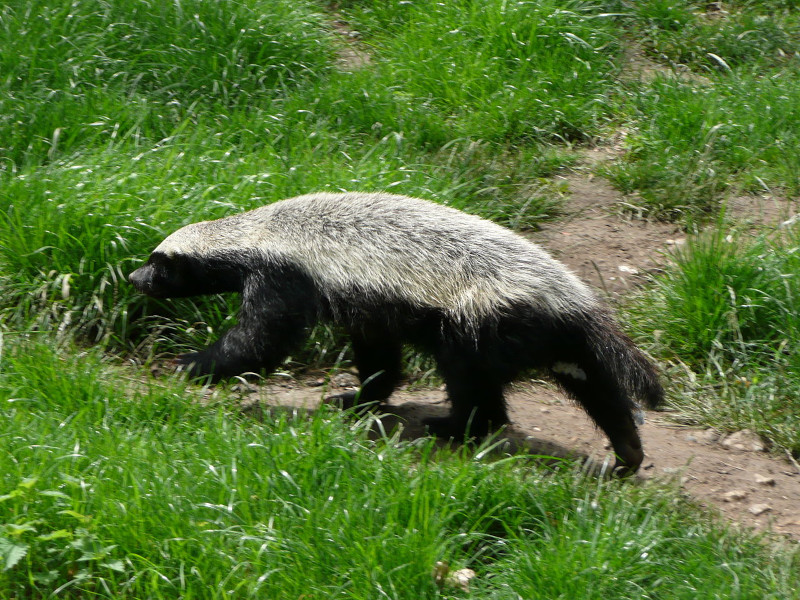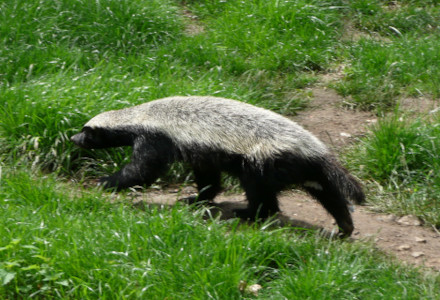
Honey Badger Facts
- This truly impressive creature most frequently goes by the somewhat informative, yet certainly descriptive, common name of the Honey Badger. The remarkable animal does, however, also go by another, alternate name. That’s the short term of the ratel.
- Professionals, however, such as researchers, tend to refer to the mammal by its technical name. That’s the relatively simple to pronounce term of Mellivora capensis. Yet, regardless of the term one chooses to employ, it remains an intriguing species.
- It also owes its recognition to the German naturalist, Johann Christian Daniel von Schreber. That’s because this respected scientist made the first acknowledgement of it as a separate and distinct species. This noteworthy event occurred in 1776.
- He didn’t assign it the name it holds now, though. He originally gave the newly recognized species the name Viverra capensis. The current name owes its existence to the efforts of others, including Gottlieb Conrad Christian Storr, and John Edward Gray.
- Fortunately, the Honey Badger appears to be maintaining a population base that’s both sizeable and stable. This trend also seems to hold true throughout the entirety of its natural range. The IUCN, therefore, presently lists it as Least Concern on its Red List.
- The animal nevertheless faces potential threats to its existence. These, in fact, it shares with most species around the world. Habitat loss, due to human expansion, certainly qualifies as one. Its greatest threat, though, now likely consists of climate change.
Related Articles
Honey Badger Physical Description
The incredible Honey Badger evolved a most distinctive physical appearance. Though this attribute certainly isn’t its only claim to fame, it’s nonetheless a noteworthy one. The impressive creature is therefore easily recognizable in all parts of its native range.
Like many of its relatives, however, this Mustelidae, displays a fairly strong degree of the characteristic of sexual dimorphism. In its case, this principally manifests itself in terms of sheer physical size. In all other ways, therefore, the sexes appear identical.
More precisely, the males attain a much greater average physical size than their female counterparts. The larger males range in body length from 22 – 30 in (55 – 77 cm) in body length. The impressive tail also adds an additional 4.7 – 11.8 in (12 – 30 cm).
At the shoulder, meanwhile, males average 9.1 – 11 in (23 – 28 cm) in height. Weights, though, vary depending on region, even among the same gender. Overall, however, this measurement equals roughly 14 – 26 lbs (6.4 – 12 kg) for the much larger males of the species.
The females, though, attain sharply different measurements. This gender of the species attains an overall average weight from different regions of about 30 – 40 percent less than that of the males. The other body measurements follow the same approximate ratio.
Both sexes of the Honey Badger othwrwise appear virtually identical. This includes a thick and broad body shape. The head’s small and flat, and the skin’s extremely thick and strong. The body presents as dark black, except for a large white band on the upper body.
- Kingdom: Animalia
- Phylum: Chordata
- Class: Mammalia
- Order: Carnivora
- Family: Mustelidae
- Genus: Mellivora
- Species: M. capensis
Honey Badger Distribution, Habitat, and Ecology
Fortunately, both for the fascinating Honey Badger itself, and for those of us who appreciate Nature, it has an extensive range of habitation. In point of fact, this astounding product of evolution actually evolved as native to a comparatively broad swathe of the globe.
More precisely, though, in addition to other regions, the powerful mammal evolved as indigenous to a large portion of sub-saharan Africa. From there, however, its range extends through such areas as Arabia, Iran, and even reaches as far as western Asia.
Within that already expansive zone of habitation, however, it displays even greater versatility in term so fits choice of habitat types. That’s due to the fact that the mammal appears in virtually every ecosystem within that range. This provides it with a great advantage.
This flexibility in where it lives also extends to altitudes. That’s because some populations live at or near sea level in parts of its range. In other areas, meanwhile, many groupings appear, and in equal numbers, at elevations of up to 13,123 ft (4,000m) above sea level.
Throughout the majority of their lives, most individuals live a primarily solitary life. During breeding season, though, pairs do occasionally hunt together. Though primarily carnnivorous in nature, individuals do sometimes augment their diet with vegetables.
Interestingly, the Honey Badger possesses the most varied diet of any known member of its Family, except for the wolverine. This includes various, rodents, insects, and snakes, even poisonous ones. It also often raids beehives for honey, thus the common name.
Species Sharing Its Range
Check out our other articles on 5 Appalchian Mountains Species, Reef Manta Ray, Atacama Desert, Indigo Milk Cap, African Tulip Tree, Giant Girdled Lizard, Long-Horned Orb Weaver

